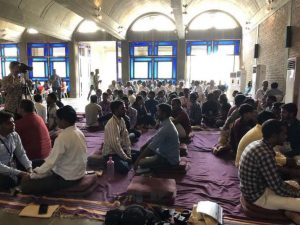Beginner’s Mind is a special project from BDG collecting insightful essays written by US college students who have attended experiential-learning courses related to Buddhism. Some of the authors identify as Buddhists, for others it is their first encounter with the Buddhadharma. All are sharing reflections and impressions on what they’ve learned, how it has impacted their lives, and how they might continue to engage with the teaching.
Vicente Gil hails from Philadelphia and attends Trinity College (Class of 2026) in Hartford, Connecticut, as a neuroscience major. They wrote this essay for their Buddhist Economics course during their sophomore fall term. While planning to pursue a cellular and molecular major concentration, the author’s keen attention to precision in writing leaves them wondering about a career in scientific writing. They enjoy rock climbing and performing with their bands.

Stillness in Motion
Gleaming white ribbons of snow cut through the ubiquitous foliage spanning the mountain as I gleaned a glance of its trails from the base. Silent as I was, the thought that I might abstain from skiing crossed my mind. Thinking about the second precept of the aṣṭāṇga-śīla (the Eight Precepts): refraining from taking that which is not given, I had wondered whether I should abstain from paying for a lift ticket because that stood in opposition to it. I hadn’t been able to make a choice, but now with the prospect of breaking a two-season ski-drought so close, I decided to live with the moral dilemma.
I crunched my way over to the lift line with my skis slung over a shoulder, before tossing them down. Click-clack, click . . . click-clack as I clipped into my bindings. I tested the surface on my way through the line before being swept up by the lift: a bit stickier than ideal, but more than passable. My friends spoke about trivial resort-mountain tropes, such as where the nearest bra tree was maintained and their excitement, but I soon tuned them out. I felt the weight of my skis on my boots as they hung off my feet. The air sliced through my buff and a comfortably familiar chill greeted my skin, and before I knew it, the “Tips Up!” signage had arrived and I was off the lift.
That first run was easy to get through from a technical standpoint. It had been two years since my last time on the slopes and my legs were still shaky, but one of my friends had never skied before, so she was falling every couple meters. This meant that I, along with my friends, was stopping every couple of meters to wait for her. It meant that I was unable to pick up any real speed, which did sort of irk me.
Then I remembered a section of Tin Tin Lay’s Building of Peace and Harmony through Buddhism: “Don’t allow yourself to hate one another. It’s only normal that when people live together, their behavior isn’t going to be on an equal level.” (Lay, 2014, 209) Just because one of us wasn’t yet proficient in the art of skiing wasn’t a real reason to feel irked. She was doing her best, and to her credit was at the top of a real mountain with zero experience. Falling was inevitable. What was different was her attitude that allowed her to push through that lack of comfort and the physical pain from falling to continue skiing. I realized that if she could put up with it, then so could I.
The more proficient of my friends did, however, become disappointed with our pace around our slower friend, so we eventually chose to split up to ski more interesting routes. As I continued to slide in silence, awareness in my skis returned: the way my inside and outside edges could work in tandem to allow me to push through a corner and maintain speed, the way my bases made easy contact with the snow on a 180-degree switch from forward to backward, and vice versa. It felt marvelous, and before long I had skied enough to feel it in my thighs.
By the end of the day they were burning, but even that awareness I was thankful for. I had spent many hours remembering how to glide across snow, but in the end I still couldn’t speak and I still couldn’t eat. The irony of my reality struck me as I listened to my friends relax and converse freely over dinner. I chose at that moment to head off to bed, and thus save myself some strife, and it felt good to finally lay down. I felt my stomach rumble, smiled, and gently drifted off to sleep.
References
“The Eight Precepts: attha-sila”: https://www.accesstoinsight.org/ptf/dhamma/sila/atthasila.html
Lay, Tin Tin. 2014. “Building up Peace and Harmony through Buddhism: Pragmatic Values of the Ovāda Pātimokkha”: 199–213. Workshop 4: Buddhist Contribution to Global Peace-Building, The 11th United Nations Day of Vesak in Vietnam: Buddhist Perspectives Towards Achieving the UN Millennium Development Goals. Ninh Binh, Vietnam.
Related features from BDG
Part of the Ocean: On Buddhism and Islam
Beyond the Stereotype: Challenging the Perception of a Peaceful Religion
A Tree Grows in Hartford
Brutal Buddhism – Looking for Meaning and Connection in a Fragmented World













